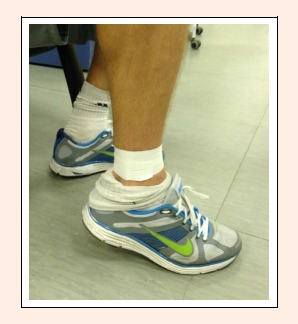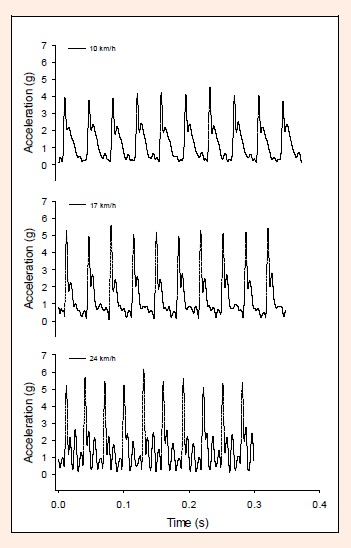Abstract
The aim of the present study was to examine the ability of a GPS-imbedded accelerometer to assess stride variables and vertical stiffness (K), which are directly related to neuromuscular fatigue during field-based high-intensity runs. The ability to detect stride imbalances was also examined. A team sport player performed a series of 30-s runs on an instrumented treadmill (6 runs at 10, 17 and 24 km·h-1) with or without his right ankle taped (aimed at creating a stride imbalance), while wearing on his back a commercially-available GPS unit with an embedded 100-Hz tri-axial accelerometer. Contact (CT) and flying (FT) time, and K were computed from both treadmill and accelerometers (Athletic Data Innovations) data. The agreement between treadmill (criterion measure) and accelerometer-derived data was examined. We also compared the ability of the different systems to detect the stride imbalance. Biases were small (CT and K) and moderate (FT). The typical error of the estimate was trivial (CT), small (K) and moderate (FT), with nearly perfect (CT and K) and large (FT) correlations for treadmill vs. accelerometer. The tape induced very large increase in the right - left foot ∆ in CT, FT and K measured by the treadmill. The tape effect on CT and K ∆ measured with the accelerometers were also very large, but of lower magnitude than with the treadmill. The tape effect on accelerometer-derived ∆ FT was unclear. Present data highlight the potential of a GPS-embedded accelerometer to assess CT and K during ground running.
Key points.
GPS-embedded tri-axial accelerometers may be used to assess contact time and vertical stiffness during ground running.
These preliminary results open new perspective for the field monitoring of neuromuscular fatigue and performance in run-based sports
Key words: Movement tracking, fatigue monitoring
Introduction
Monitoring acute neuromuscular fatigue is important for all run-based sports, and has various implications including training load management to prevent injuries and/or rotation/substitution strategies during matches. The ability to assess running strides asymmetries, and in turn, possible lower-limb muscle strength imbalances can also provide important information with respect to injury risk, during both normal and rehabilitation training (Fousekis, Tsepis et al., 2011). Classical time-motion analyses in team-sports, which include distance covered into specific speed (Carling, 2013), acceleration and deceleration (Aughey, 2011) zones, and accelerometer-derived measures of overall ‘body load’ (Barrett et al., 2014), are unfortunately largely dependent on match pace and might therefore lack of sensitivity to detect neuromuscular fatigue per se. It is actually well understood today that running activity during matches is more related to match tactics and score line than fatigue or fitness per se (Carling, 2013).
Recent results have nevertheless suggested that micro-sensors, such as the accelerometers included in the GPS units worn by the majority of team sport players (i.e., GPS-imbedded accelerometers) may provide, in comparison with classical locomotor-related data, more fatigue-sensitive measures. For example, in fatigued elite Australian Rules footballers showing at least an 8% decreased flight time: contraction time ratio from a countermovement jump, there was a reduction in the contribution of the vertical axis to the total accelerometer load during matches (Cormack et al., 2013). Unfortunately, the actual meaning of the vertical axis loading remains partially unclear, since it doesn’t represent a clear biomechanical/locomotor entity. Possibly more promising accelerometer-derived measures may include contact time (CT) and vertical stiffness (K) (Gaudino et al., 2013), which are common stride variables, and have been shown to be largely affected by acute neuromuscular fatigue during repeated high-intensity runs (Morin et al., 2006, Girard et al., 2011). However, the validity of accelerometer-derived CT, flying time (FT) and K have not been examined yet. Whether accelerometer-derived data can also accurately detect stride asymmetries is also, to our knowledge, still unclear.
The aims of the present study were to examine the ability of GPS-imbedded accelerometers 1) to assess stride variables and vertical stiffness and 2) to detect stride asymmetries during running.
Methods
Participant and design
Using a single-subject design protocol, a 36-y old team sport player (1.82 m, 80 kg) performed a series of 30-s runs at a 1% incline on a motorized instrumented treadmill (ADAL3D-WR, MD, HEF Tecmachine, Andrézieux-Boutheon, France): 2 sets of 3 runs at 10 km·h-1, 6 at 17 km/h and 6 at 24 km·h-1) with or without his right ankle taped (aimed at slightly shortening/stiffening the Achilles tendon and in turn, creating a stride imbalance, Figure 1). The player was highly familiar with treadmill running, and had no history of lower-limb injury. Tapping the right side was an arbitrary choice. Given the fact that the player had no history of previous injury, there is no reason to think that the side of the taping would have influenced the outcome of the present study. There was a 45-s rest between each trial to minimize fatigue, and a 3-min break between each set. The duration of each set was therefore ~11-min long. At the end of each run, the player stopped running immediately and placed his feet on each side of the belt while holding the handlebars, before re-loading the treadmill at the end of each rest; the treadmill was never stopped so that the speed could be adjusted for the next run. The order of each run was randomized (e.g., 17, 10, 24, 17, 24, 10, 10, 27 km·h-1, etc.) within each set for each running condition, with the taped condition performed during set 2 and 4. The testing sequence was therefore the following: 3 runs at each speed untaped, 3 runs at each speed taped, 3 runs at each speed untaped and 3 runs at each speed taped. To make sure that the tape effect was consistent and reproducible across set 2 and 4, the same length of tape was used and it was repositioned at the same place on the player’s leg. During the 4 series of runs, the player wore positioned between his scapulars and at the approximate level of T2, a commercially-available GPS unit (SPI HPU, GPSports, Canberra, Australia) with an embedded 100-Hz triaxial accelerometer. The GPS unit was held securely in a manufacturer recommended GPS-vest, as previously described (Aughey, 2011). The GPS unit and imbedded accelerometer was vertically-oriented (Z axis) when the player was standing upright, the Y axis was orientated to forward-backward horizontal movement and the X axis was orientated to the left-right lateral deviations. Similar accelerometer data have shown good reliability when collected on football players during football-specific training exercise (Boyd et al., 2011).
Figure 1.

Achilles tendon taped to create the stride imbalance.
Methodology. CT and FT were computed as previously described from both treadmill (based the vertical ground reaction force signal) (Morin et al., 2005) and accelerometers (Gaudino et al., 2013) (Athletic Data Innovations, using the magnitude vector, Figure 2) data by two independent scientists. Both scientists were blind to the data obtained with the other device; the data were then pooled by a third scientist who calculated vertical stiffness for both devices using Morin et al.’s equation (Morin et al., 2005). Briefly, this equation is based on a sine-wave modeling of the vertical ground reaction force during the support phase, and uses CT, FT and subject’s body mass as computation inputs. Vertical reaction force data obtained with the treadmill were sampled at 1000 Hz during a 30-s period. For each run, after appropriate filtering (Butterworth-type 30 Hz low-pass filter, based on pilot residual analyses), instantaneous values of vertical ground reaction force were analyzed for 10 consecutive steps. CT and FT were determined for each step using a 30 N threshold (Figure 2, once strides were stabilized, i.e., generally after the initial 10-12 steps). The accelerometer-derived data was processed using a fourth-order Butterworth filter (20-Hz cut-off, sampling frequency 100 Hz) aimed at reducing signal noise. Detection algorithms (Athletic Data Innovations) were used to recognize foot strikes based on the magnitude vector and the relationship between the Y and Z components of the accelerometer data. Due to the alignment of the unit on the subject’s upper back, the axial components of the accelerometer data are not truly vertical or frontal, but change with the varying orientation of the subject’s torso. The side of the foot strike (left vs. right) was assigned using a two-pass algorithm (Athletic Data Innovations) utilizing primarily the X component of the accelerometer. CT and FT were calculated using the filtered accelerometer-derived data by determining the time between the ‘foot strike start positon’ and the ‘foot strike end position’ (CT) using the previously mentioned detection algorithm. Consequently, the time between the ‘foot strike end position’ and the next ‘foot strike start position’ were used to determine FT. To increase the sample size and allow a correlation analysis with sufficient statically power representative of the wide range of steps encountered during training and matches, the data from the 18 runs were then pooled together for analysis (3 speeds x 6 runs x 10 steps = 180 steps).
Figure 2.

Accelerometer-derived magnitude vector during 10 successive steps, as measured for the three different running speeds (untaped condition).
Statistical analysis
The agreement between treadmill (criterion measure) and accelerometer-derived data was examined using a specifically-designed spreadsheet (Hopkins, 2000), which calculated the mean bias (90% confidence limits, CL) and the typical error of the estimate (TEE, 90% CL) both in percentage and standardized units, and Pearson correlation coefficients (r, 90% CL). We also compared the ability of the different systems to detect the stride imbalance using magnitude-based inferences (Hopkins et al., 2009). Threshold values for biases, TEE and standardized differences, were >0.2 (small), >0.6 (moderate), >1.2 (large) and very large (>2) (Hopkins et al., 2009). Finally, the following criteria were adopted to interpret the magnitude of the correlation: ≤0.1, trivial; >0.1-0.3, small; >0.3-0.5, moderate; >0.5-0.7, large; >0.7-0.9, very large; and >0.9-1.0, almost perfect. If the 90% CI overlapped small positive and negative values, the magnitude was deemed unclear; otherwise that magnitude was deemed to be the observed magnitude (Hopkins et al., 2009).
Results
Biases were small (CT, -10.4%; 90CI: -12.3, -9.8; K -13.3%; -14.6, -11.9) and moderate (FT, -25.8%; -18.8, -27.7). The typical error of the estimate was trivial (CT: 3.9%, 3.4, 4.6), small (K: 6.3%; 5.5, 7.5) and moderate (FT: 15.7%; 13.5,18.9), with nearly perfect (CT: r = 0.98; 90%CI 0.97, 0.99; K: 0.98; 0.97, 0.99) and large (FT: 0.68; 0.55, 0.78) correlations for treadmill vs. accelerometer.
The tape induced very large increase in the right - left foot ∆ in CT (4.5%; 4.2, 4.9), FT (7.0%; 2.3, 11.3) and K (10.3%; 8.6, 12.0) on the treadmill. The tape effect observed with the accelerometer on CT (3.7%, 2.3, 5.0) and K (6.4%, 3.8, 9.2) were also very large but of lower magnitude than with the treadmill (∆ in the ∆ CT: -0.9%, -2.4, 0.7 and K: -3.9%, -7.5, -0.3). The accelerometer-derived tape effect on FT was unclear (0.3%, -3.7, 4.3).
Discussion
The first result of this preliminary study was that stride variables and vertical stiffness could be accurately estimated using 100-Hz GPS-embedded triaxial accelerometers. While the promise of such devices to detect stride variables have already been reported (Gaudino et al., 2013), this is to our knowledge the first time that the data derived from a GPS-embedded tri-axial accelerometer were directly compared with a gold standard (i.e., vertical ground reaction force obtained from an instrumented treadmill) over several steps. Compared with the criterion measures obtained with the treadmill, the biases and typical errors were of small-to-moderate amplitude only, with nearly perfect to large correlations between the two technologies. Considering both the practical (outdoor use of a portable and individual device vs. lab-based and stationary device) and economical aspects of the accelerometer technology (instrumented treadmill or force plates systems cost up to 100 times more than accelerometers), and since CT and K are two important determinants of high-intensity running performance (Girard et al., 2011; Morin et al., 2006), our preliminary results open new perspectives for the field monitoring of neuromuscular fatigue. The smaller relative bias and greater CV reported for FT compared with CT may not reflect real differences in validity and reliability per se given the strong inter-dependency of both measures (i.e., when the athlete’s foot is not in contact with the ground it could only be in the air). This is likely the result of the smaller absolute values of FT (0.10-0.15 s) compared with CT (0.15-0.25 s), which artificial increases the magnitude of the bias and TEE values when expressed in percentage.
The second important finding of the present study was the ability of the GPS-embedded accelerometer to detect stride imbalances. While the tape-related imbalance could be detected via the analysis of all the treadmill variables (right-left differences in CT, FT and K were all very large), the imbalance was only apparent on CT and K measures with the GPS-embedded accelerometer, and of a smaller magnitude than with the treadmill. Despite a slightly lower sensitivity to the stride imbalance, the accelerometer-derived data are likely relevant enough to detect running asymmetries in the field, which highlights the interest of such devices for the monitoring of potential lower-limb strength asymmetries in athletes.
A limitation of the present preliminary study however is that all measures were collected on a single subject; whether similar results would be reported in various individuals with different anthropometrical attributes, stride patterns and running experiences still remains to be examined.
Practical applications
Today, almost all GPS systems, whatever the brand, include high-frequency tri-axial accelerometers in their individual units. Both manufacturer-provided (e.g., Team AMS for GPSports, Sprint for Catapult) and custom-made softwares (e.g., Athletic Data Innovations) allow automated and rapid stride analysis, which increases both the quantity and the quality of the data collected on each player. Since contact time and vertical stiffness are two important determinants of high-intensity running performance (Morin et al., 2006, Girard et al., 2011), and given the possible prognostic of lower-limb strength asymmetries (Fousekis et al., 2011), our results open new perspectives for the field monitoring of neuromuscular fatigue. Another very important aspect of the present technology is that accelerometers can be used indoor (i.e., no GPS signal needed), which in fine allows their use for almost every type of run-based type of sports (e.g., basketball, handball).
Conclusion
Present data highlight the potential of GPS-embedded tri-axial accelerometers to assess contact time and vertical stiffness during ground running. Since these two latter variables are important determinants of high-intensity running performance (Morin et al., 2006, Girard et al., 2011), and since lower-limb strength imbalances may be related to a higher injury risk (Fousekis et al., 2011), our preliminary results open new perspective for the field monitoring of neuromuscular fatigue and performance in run-based sports.
Acknowledgements
The authors thank Franck Brocherie, Olivier Girard and Sean O’Connor for their help with data collection.
Biographies

Martin BUCHHEIT
Employment
Sport Science Department, Myorobie Association, Montvalezan, France; Performance Department, Paris Saint-Germain Football Club, Saint-Germain-en-Laye, France;
Institute of Sport, Exercise and Active Living, College of Sport and Exercise Science, Victoria University, Melbourne, Australia
Degree
PhD, MSc, Strength & Conditioning and Satistics
Research interest
Training monitoring and prorgramming
E-mail: mb@martin-buchheit.net

Andrew GRAY
Employment
Cronulla Sharks Rugby League Football Club, NSW, Australia
Athletic Data Innovations, Sydney, NSW, Australia
Degree
MSc, Strength & Conditioning, Physiotherapy
Research interest
Training monitoring
E-mail: athleticdatainnovations@bigpond.com

Jean-Benoit MORIN
Employment
Full Professor, University of Nice Sophia Antipolis, Faculty of Sport Sciences, France
Degree
PhD
Research interest
Sports Performance, Running Mechanics, Sprint Mechanics, Injury Prevention
E-mail: jean-benoit.morin@unice.fr
References
- Aughey R.J. (2011) Applications of GPS technologies to field sports. International Journal of Sports Physiology and Performance 6, 295-310. [DOI] [PubMed] [Google Scholar]
- Barrett S., Midgley A., Lovell R. (2014) PlayerLoad: reliability, convergent validity, and influence of unit position during treadmill running. International Journal of Sports Physiology and Performance 9, 945-952. [DOI] [PubMed] [Google Scholar]
- Boyd L.J., Ball K., Aughey R.J. (2011) The reliability of MinimaxX accelerometers for measuring physical activity in Australian football. International Journal of Sports Physiology and Performance 6, 311-321. [DOI] [PubMed] [Google Scholar]
- Carling C. (2013) Interpreting physical performance in professional soccer match-play: should we be more pragmatic in our approach? Sports Medicine 43, 655-663. [DOI] [PubMed] [Google Scholar]
- Cormack S.J., Mooney M.G., Morgan W., McGuigan M.R. (2013) Influence of neuromuscular fatigue on accelerometer load in elite Australian football players. International Journal of Sports Physiology and Performance 8, 373-378. [DOI] [PubMed] [Google Scholar]
- Fousekis K., Tsepis E., Poulmedis P., Athanasopoulos S., Vagenas G. (2011) Intrinsic risk factors of non-contact quadriceps and hamstring strains in soccer: a prospective study of 100 professional players. British Journal of Sports Medicince 45, 709-714. [DOI] [PubMed] [Google Scholar]
- Gaudino P., Gaudino C., Alberti G., Minetti A.E. (2013) Biomechanics and predicted energetics of sprinting on sand: hints for soccer training. Journal of Science andMedicince in Sport 16, 271-275. [DOI] [PubMed] [Google Scholar]
- Girard O., Micallef J.P., Millet G.P. (2011) Changes in spring-mass model characteristics during repeated running sprints. European Journal of Applied Physiology 111, 125-134. [DOI] [PubMed] [Google Scholar]
- Hopkins W. (2000) Analysis of validity by linear regression (Excel spreadsheet). In: A new view of statistics. sportsci.org: Internet Society for Sport Science. Available form URL: http://sportsci.org/resource/stats/xvalid.xls.
- Hopkins W.G., Marshall S.W., Batterham A.M., Hanin J. (2009) Progressive statistics for studies in sports medicine and exercise science. Medicince and Science in Sports and Exercise 41, 3-13. [DOI] [PubMed] [Google Scholar]
- Morin J.B., Dalleau G., Kyrolainen H., Jeannin T., Belli A. (2005). A simple method for measuring stiffness during running. Journal of Applied Biomechanice 21, 167-180. [DOI] [PubMed] [Google Scholar]
- Morin J.B., Jeannin T., Chevallier B., Belli A. (2006) Spring-mass model characteristics during sprint running: correlation with performance and fatigue-induced changes. International Journal of Sports Medicine 27, 158-165. [DOI] [PubMed] [Google Scholar]


